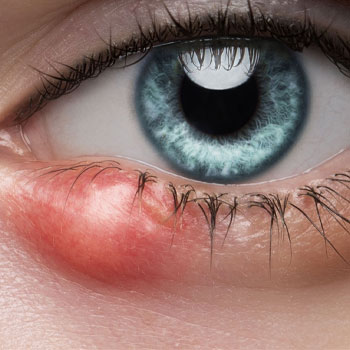Chalazion
- Home
- Services
- Chalazion
A chalazion is a common, non-contagious eye condition that typically affects the eyelids. It appears as a small, painless lump or swelling, often on the upper eyelid, due to a blocked or inflamed oil gland. While chalazia (plural of chalazion) are generally not harmful, they can cause discomfort and may impact the aesthetic appearance of the eye area. Understanding the condition, its symptoms, and when to seek medical help can help manage it effectively.
What is Chalazion?
A chalazion occurs when one of the small oil-producing glands located along the edge of the eyelid, known as meibomian glands, becomes blocked. These glands help lubricate the surface of the eye by secreting oils. When the gland becomes obstructed, the oil builds up, leading to inflammation and the formation of a painless, firm lump
Although chalazia can occur on both the upper and lower eyelids, they are more commonly found on the upper eyelid due to its higher number of meibomian glands. These lumps often start small and may gradually grow larger over time if left untreated

Symptoms of Chalazion
The symptoms of a chalazion can vary from person to person. Some people may experience only mild symptoms, while others may face more discomfort. Common signs and symptoms include
- Painless lump: The most prominent feature of a chalazion is a small, painless lump that forms under the skin of the eyelid. It may be soft or firm to the touch.
- Swelling and redness: While a chalazion is typically not painful, the eyelid may appear swollen, and the surrounding area may become slightly red or irritated.
- Blurred vision: In some cases, the chalazion may grow large enough to press against the eyeball, causing temporary blurred vision.
- Tenderness or discomfort: Although not typically painful, a chalazion can become tender, especially if it becomes infected.
- Excessive tearing: Some individuals may experience increased tear production as a response to the irritation caused by the chalazion.
Causes and Risk Factors
The primary cause of a chalazion is a blocked meibomian gland. However, certain factors may increase the likelihood of developing this condition. These include
- Blepharitis: Chronic inflammation of the eyelid, known as blepharitis, can increase the risk of developing chalazia. This condition often leads to clogged oil glands.
- Skin conditions: Conditions like rosacea or seborrheic dermatitis, which affect the skin's oil production, can predispose individuals to chalazion formation.
- Poor hygiene: Not properly cleaning the eyelid area can result in clogged glands and increased risk of developing a chalazion.
- Infection: While a chalazion is not infectious, an existing eye infection can increase the chances of developing one.
When to Seek Medical Attention?
Although a chalazion is usually harmless and may resolve on its own, there are instances when you should seek medical advice or treatment. Here are the situations when professional care is recommended
- Larger or persistent chalazion: If the lump persists for several weeks without improvement, or if it grows significantly in size, medical intervention is necessary.
- Pain and tenderness: While a chalazion is typically painless, it can become painful if infected. If you notice any tenderness or increased discomfort, it’s important to consult an eye care specialist.
- Vision problems: If the chalazion is affecting your vision by pressing against the eye, leading to blurred vision or irritation, seeking medical treatment is essential.
- Infection: If the chalazion becomes red, swollen, or warm to the touch, these could be signs of infection, and you should see a doctor immediately.
Treatment Options for Chalazion
Most chalazia do not require surgery and can be treated with simple home remedies and over-the-counter treatments. However, in some cases, medical procedures may be necessary. Here are common treatment methods
- Warm compress: Applying a warm, moist compress to the affected eyelid several times a day can help loosen the blockage and encourage drainage of the oil gland.
- Massage: Gently massaging the eyelid after applying a warm compress can help move the oils and promote healing.
- Topical medications: In some cases, a doctor may recommend antibiotic ointments or steroid creams to reduce inflammation and prevent infection.
- Drainage procedure: If the chalazion doesn’t improve with conservative treatments, a doctor may perform a minor surgical procedure to drain the lump. This procedure is typically quick and is done in a sterile environment to prevent infection.
Pure Vision: Best Chalazion Hospital in Vijayawada
For residents of Vijayawada, if you are dealing with a chalazion or any other eye condition, Pure Vision offers comprehensive care with expert diagnosis and treatment options. As one of the leading eye hospitals in Vijayawada, Pure Vision is equipped with state-of-the-art technology and a team of highly qualified ophthalmologists specializing in eyelid disorders, including chalazia
The team at Pure Vision is dedicated to providing personalized care tailored to each patient's needs. Whether you require conservative treatments like warm compresses and medications or a more advanced procedure like surgical drainage, the hospital's experienced specialists ensure that you receive the most effective care possible
Additionally, Pure Vision’s commitment to patient education ensures that you fully understand your condition and treatment options. With a patient-first approach, the hospital strives to deliver the highest standard of care in a compassionate and comfortable environment
Chalazion is a relatively common condition that, while not usually serious, can be bothersome if not treated correctly. Understanding its symptoms, causes, and treatment options can help you manage the condition effectively. Remember, if you experience any concerning symptoms or if the chalazion does not improve with home treatments, it’s essential to seek professional help. Pure Vision in Vijayawada stands out as the best option for chalazion treatment, offering expert care to help you restore your eye health
If you’re experiencing a chalazion or any eye-related concerns, contact Pure Vision today for an appointment and ensure the best possible care for your eyes
Why Choose Us
Expert Ophthalmologists

Advanced Technology

Comprehensive Services

Patient-Centered Care

